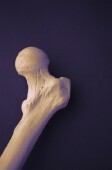Epilepsy Drug Linked to Bone Loss
Women on Dilantin may want to consider other seizure medications, experts say.
By Amanda Gardner
HealthDay Reporter
|
E-mail this article
Subscribe to news
Printer friendly version
|

(SOURCES: Alison M. Pack, M.D., assistant professor, clinical neurology, Columbia University, New York City; Steven V. Pacia, M.D., director, division of neurology, Lenox Hill Hospital, New York City; R. Eugene Ramsay, M.D., director, International Center for Epilepsy, University of Miami Miller School of Medicine; April 29, 2008, Neurology
)
MONDAY, April 28 (HealthDay News) -- The epilepsy drug Dilantin may put young women who take it for a year or more at higher risk for osteoporosis, researchers report.
The bone loss described in a paper in the April 29 issue of Neurology was actually eight times higher than that experienced by premenopausal women who did not take any drugs for epilepsy.
"That suggests that if these women remain on this medication and have ongoing significant or accelerated bone loss that over time, they will be entering the peri-menopausal period with lower bone density and therefore a greater risk for low bone mineral density over time and therefore a higher risk of fractures," said study lead author Dr. Alison M. Pack, assistant professor of clinical neurology at Columbia University in New York City.
According to Dr. R. Eugene Ramsay, director of the International Center for Epilepsy at the University of Miami Miller School of Medicine, 90 percent of older people who have seizures are put on Dilantin, largely because it's inexpensive.
"It's particularly important, because the older population has the highest incidence of epilepsy. There are more new-onset seizures occurring there, and yet they are getting the cheapest and worst treatment," he said.
The findings are not entirely new, since previous research had already revealed an adverse effect on anti-epileptic drug treatment (Dilantin and other drugs) on bone and mineral metabolism. One previous study found that anti-seizure drugs had the same effect on the incidence of osteoporosis in older men as it did in older women, Ramsay said.
This study involved 93 premenopausal women (aged 18 to 40) with epilepsy, each of whom was taking either Dilantin (phenytoin), Tegretol (carbamazepine), Lamictal (lamotrigine) or Depakote (valproate).
The study was partially supported by GlaxoSmithKline, which makes Lamictal. Pack has also received funding from this and other pharmaceutical companies.
All participants took 1,000 milligrams of calcium a day and were physically active, both good strategies to maintain bone health.
After one year, women taking Dilantin lost 2.6 percent of their bone density in the femoral neck of the hip, while bone mineral density stayed about the same in the other three groups.
Bone mineral density stayed the same at the spine and the total hip.
The speed (one year) at which Dilantin affected bone health was surprising, said Dr. Steven V. Pacia, director of the division of neurology at Lenox Hill Hospital in New York City.
Women who need to take epilepsy drugs can either switch to a medication other than Dilantin, or they can up their intake of calcium, said Pack.
But according to Pacia, calcium supplementation may not be enough to counteract the bone-depleting effect of Dilantin.
"There may be a direct affect on bone absorption of calcium," Pacia said. "If the mechanism is damaged, the bone is not going to be able to take up calcium. An alternate drug that doesn't cause the same problem is preferable. In the rare cases we had to use [Dilantin], drugs like Fosamax and Boniva can be used to try to counteract the effect, and that does happen."
"We're just beginning to recognize that we need to look at the long-term health care issues of anti-convulsants," Ramsay said.
More information
The Epilepsy Foundation  has more on this condition.
has more on this condition.
Copyright © 2008 ScoutNews, LLC. All rights reserved. 
HealthDayNews articles are derived from various sources and do not reflect federal policy. healthfinder.gov does not endorse opinions, products, or services that may appear in news stories. For more information on health topics in the news, visit the healthfinder.gov health library.